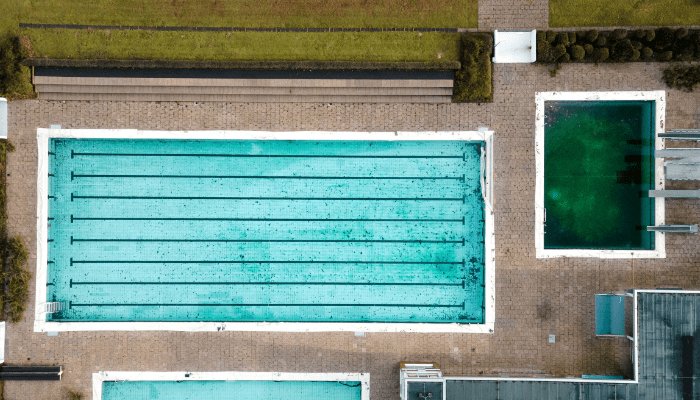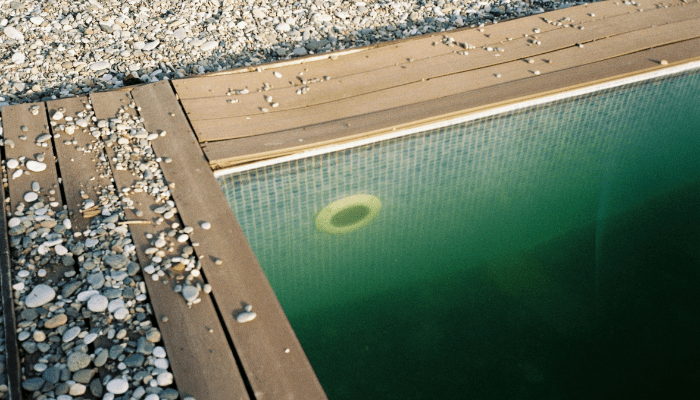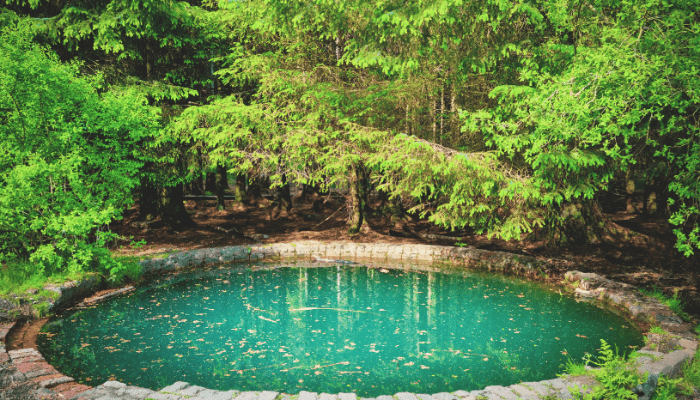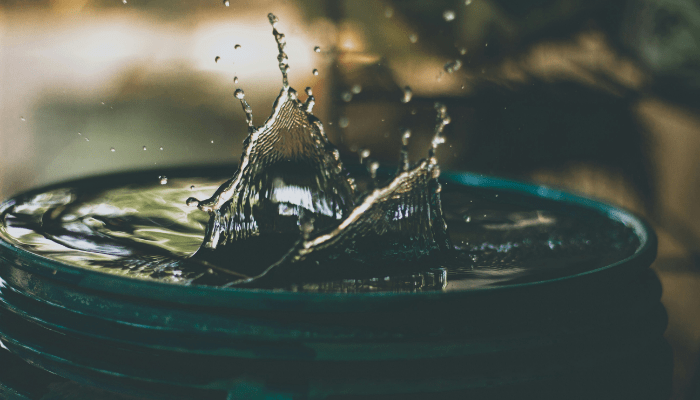Key Takeaways
Pool flocculants clump tiny particles so they sink, helping clear up cloudy water, but they only provide a temporary fix.
Flocculants require precise use and careful vacuuming; too much can create a sticky mess and waste significant water.
Cloudy water usually points to deeper issues like poor filtration, chemical imbalance, or dead algae, not just particles floating around.
A smarter approach is prevention: upgrade your filter, keep chemistry balanced, improve circulation, and use natural clarifiers when possible.
For a long-term solution, natural swimming pools offer clear water without chemicals, relying on plants and bio-filtration for low-maintenance clarity.

There’s nothing worse than walking out to your pool, ready for a swim, only to find it looking like a murky pond. Cloudy water is the enemy of every pool owner. It ruins the look, feels gross, and makes you question whether you’re about to swim or wade through a science experiment.
Enter pool flocculants, a chemical solution designed to clump tiny particles together so they sink to the bottom, making them easier to vacuum out. Sounds great, right? In theory, yes. In practice, it’s a bit more complicated.
Flocculants can be a lifesaver. But they can also be a pain. They require precision. Get it wrong, and you’re left with a gooey mess at the bottom of your pool. Plus, they don’t actually fix the problem, just mask it.
So, what’s the real solution? How do you keep your pool crystal clear without constantly relying on chemicals? Let’s break it all down.

What Are Pool Flocculants?
Let’s start with the basics. Pool flocculants are chemicals designed to gather tiny particles floating in your pool and make them clump together into larger masses. Once these clumps form, they sink to the bottom, allowing you to vacuum them up.
Sounds like magic, right? Just pour in the flocculant, wait a few hours, and boom – crystal-clear water. Except, there’s a catch (there’s always a catch).
Unlike pool clarifiers, which help your filter trap fine particles, flocculants force everything to the bottom in one dramatic, sink-or-swim moment. If you don’t vacuum the debris precisely and thoroughly, you’re back to square one, sometimes with an even cloudier mess than before.
Why Do Pools Need Flocculants?
Cloudy pool water isn’t just an eyesore. It’s a sign that something’s off in your pool’s balance. Here are the biggest culprits.
Dead algae floating around – Killed off by shock treatment but now suspended in the water like a horror movie aftermath.
High calcium levels – Too many dissolved minerals? Get ready for cloudy chaos.
Dirty or ineffective filters – If your filter isn’t doing its job, tiny particles keep swirling around.
Chemical imbalances – If your pH, alkalinity, or sanitizer levels are out of whack, cloudiness follows.
Flocculants can help. They grab everything and drop it to the bottom. But the problem? They don’t fix why your pool is cloudy in the first place.

The Downsides of Using Pool Flocculants
Flocculants are not the easy, one-and-done solution they seem to be. Here’s why.
It’s high maintenance – You must vacuum manually after using a flocculant. And not just any vacuuming: slow, careful, and thorough vacuuming to waste. That means losing water. A lot of it.
It doesn’t fix the root cause – If your pool is consistently cloudy, flocculants are just a temporary cover-up. Like putting makeup over a breakout instead of treating your skin.
It can backfire – Add too much flocculant? You’re in for a sticky, gooey mess that’s harder to clean than the original cloudiness.
It’s not exactly eco-friendly – Flocculants introduce extra chemicals into your water. Overuse can lead to imbalanced water chemistry, more chemical treatments, and a never-ending cycle of adding more stuff just to keep your pool clear.
So, while flocculants can work in a pinch, they’re not the best long-term strategy. Let’s talk about smarter ways to keep your pool crystal clear without constantly relying on chemicals.
Smarter, More Sustainable Ways to Keep Pools Crystal Clear
Flocculants are reactive, they fix a problem after it happens. A better approach? Prevent cloudy water in the first place. Here’s how!
Upgrade Your Filtration System
Your pool filter is your first line of defense against cloudiness. A high-quality filter catches fine particles before they become a problem. Cartridge filters work well, but DE (Diatomaceous Earth) filters are next level in trapping tiny debris.
Use Natural Pool Clarifiers
Instead of flocculants, enzyme-based clarifiers or biodegradable coagulants help trap particles naturally. Some even use chitosan, a compound made from crustacean shells (nature’s version of a clarifier!).
Balance Your Pool Chemistry
Test your pH, chlorine, alkalinity, and calcium levels regularly. A balanced pool is less likely to turn cloudy, meaning you won’t need a chemical Hail Mary later on.
Improve Circulation
Dead spots in your pool = trouble. Run your pump longer, adjust your jets, and brush your pool regularly to keep everything moving. Stagnant water breeds problems.
Consider a Natural Swimming Pool
Want to ditch chemicals altogether? Natural pools use biological filtration, plants, and natural bacteria to keep water clean: no chlorine, no flocculants, no headaches. More on that below.

Why Oásis Biosistema’s Natural Pools Are the Best Alternative
If you’re tired of the chemical cycle, there’s another way. Natural pools and ornamental ponds offer crystal-clear water without synthetic chemicals.
Self-sustaining water clarity – Instead of flocculants, plants, bio-filters, and beneficial bacteria keep the water balanced.
No more chemical balancing stress – No chlorine, no pH-adjusting rollercoaster. Just clear, natural water.
Eco-friendly and low-maintenance – No vacuuming to waste, no chemical dumping. Just a thriving, self-cleaning ecosystem.
Traditional pools demand constant chemical management. Natural pools? They just exist. Clear, clean, and effortless.
Flocculants have their place. But you don’t want to be constantly dumping chemicals into your pool. There’s a better way.
If you’re looking for a smarter, more sustainable approach to crystal-clear water, let’s talk about how Oasis Biosistema can create a pool that stays naturally clear, without the chemicals.

Conclusion: Do You Really Need Pool Flocculants?
Flocculants can work. They can take a swampy mess and make it clear again. But they’re not a long-term fix. They’re a band-aid solution, and a messy one at that.
Instead of constantly dumping chemicals in your pool, consider a smarter approach. Upgrade your filtration system. Balance your water chemistry properly. Use natural clarifiers when possible. These methods work with your pool, not against it.
And if you’re tired of the constant cycle of chemicals, there’s an even better option: natural swimming pools. No chlorine. No flocculants. Just clear, self-sustaining water that stays that way without the chemical rollercoaster.
Your pool should be a place to relax, not a high-maintenance science project. Want to learn more about sustainable, low-maintenance water solutions? Let’s talk.
Still fighting cloudy water? Maybe it’s time for a better pool.
Oásis Biosistema designs natural pools that stay crystal clear with no flocculants, no chemicals, and no stress.
Request your free quote today and swim in crystal clear water every day.
FAQ
When should I use flocculant in the pool?
Use flocculant when the pool water is very cloudy and filtration alone isn’t working.
What is better, flocculant or clarifier?
Flocculant works faster but requires manual vacuuming, while clarifier is slower but easier to use.
What is the best flocculant?
Popular options include Alum (Aluminum Sulfate) and Polymer-based flocculants like Poolife Drop Down or Clorox Pool&Spa Flocculant.
Shock first, then use flocculant if the water remains cloudy.
Primeiro, aplique o choque; se a água continuar turva, use o floculante.



